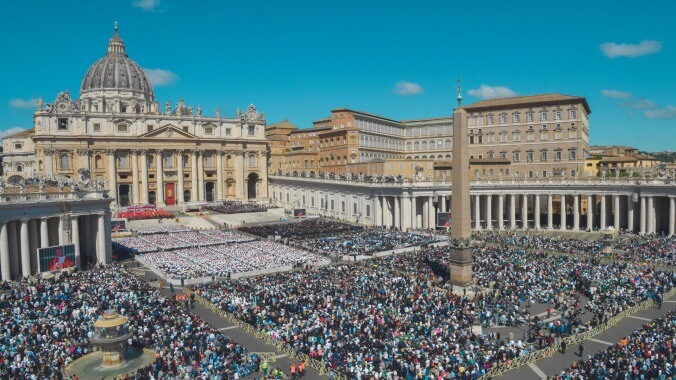An Aperol Spritz and a Catholic Mass in Rome the Day After Pope Francis’ Funeral
I have long forsaken my religious upbringing, but an Italian mass the day after the Papal funeral? It’s like Italy’s Mayhem Ball.
Photo: iStockphoto In Depth
It’s April 26, and the car that picked me up from Fiumicino Airport is careening down Rome’s narrow, cobblestoned streets, barely missing tourists. The driver (wearing one pair of eyeglasses on his forehead and another on the bridge of his nose) realized I speak the language, and is chatting rapidly in Italian about the recent death of Pope Francis while maneuvering the car like he’s in a Roman version of The Fast and the Furious.
“Dovrei accendere un fuoco per il fumo,” he jokes, suggesting he’s going to light a fire to mimic the smoke that pours from the Vatican after a new pope is selected. It’s the day after the papal funeral and weeks before the conclave (he pronounces it “con-clahv-ay”), but he’s frustrated by how many people are here in the Eternal City. (Tens of thousands flocked to Rome for the papal funeral, while hundreds of thousands of tourists traveled for the May 8 conclave).
He stops short at a traffic circle. Massive mobs stand in front of the Basilica Papale Santa Maria Maggiore (a Catholic Church of special importance and with special privileges as determined by the pope), flanked by news trucks and military vehicles. Police officers direct pedestrians, urging them to cross rather than linger in the middle of the street to gawk at the spire. Other people in more intense-looking military gear shoo tourists away from restricted areas. A group of teens wearing kelly green vests trail behind a short woman carrying a pole with a flag and an Italian woman waves her hand in frustration. It seems like all the Romans, not just my driver, want to hurry this papal process up.
Despite the chaos, there’s a bubble of respect. I was hoping to get some sort of bootleg papal funeral shirt like you’d get in the parking lot after a concert, but there are no stalls selling schlock. Throughout my entire trip, I only saw a handful of pope-related wares, and they were just t-shirts printed with a picture of Papa Francisco smiling and waving, or painted magnets of his visage. No ’90s-style collage tees or bad photoshops of him in heaven.
Pope Francis died on April 21 after suffering a stroke (and meeting JD Vance). He became pope in 2013, after Pope Benedict XVI resigned due to health issues (the first papal resignation since 1415). He was considered one of the most socially conscious popes of all time, thanks to his determination to reform and modernize the Catholic Church. As far as popes during my lifetime go, I’d rank him first. One of his final acts was ensuring that the “popemobile” would become a health clinic for the children of Gaza.
I was raised Roman Catholic in an Italian American household in Long Island, New York, which meant religion classes, communion, confirmation, and eventual abject horror at my recent divorce. I remember the 2005 death of Pope John Paul II all too well—it was my 15th birthday, and my mother spent it sobbing fat, milky tears at the Apple store. (I was getting my first iPod and didn’t care about anything else). A set of four collectible plates commemorating Pope John Paul II, his face hand-painted on each, still hangs in my parents’ kitchen.
So I have a unique relationship to all of the pageantry going on here; I’ve also never been in this city, or abroad, on my own (I’m here to see a video game preview). But after the year I’ve had (harassment, career change, breakup, new apartment, health scare), it’s a chance to be re-baptized as an Italian woman, and to don my best Catholic drag for a few days. There’s an air of importance hovering over Italy, and I’m hoping it’ll change me for the better.
My driver successfully delivered me to my hotel near Stazione Termini, the city’s main railway station and the biggest in the country. I round a corner and flatten myself against the wall to let a towheaded family of tourists schlepping their luggage pass by, but quickly realize something is up. A fourth man is following right behind the family’s patriarch, his arm outstretched, his hand shaped into a claw, his fingertips dipping below the line of the tourist’s back pocket. The “attenzione pickpocket” TikTok is happening before my eyes.
“Ay!” I shout to deter the man. He stops short, withdraws his hand, turns to face me, and stomps his feet in frustration, letting loose a slew of what I can only imagine are curses. (He’s not speaking Italian). The trio of tourists continues walking, oblivious. I shrug and about-face, trudging towards the bus that will take me to my destination, a pickpocket thwarted with absolutely no fanfare.
-

-

-

-

-

-

-

-

-

-

-

-

-

-

-

-

-

-

-

-

-

-

-

-

-

-

-

-

-

-

-

-

-

-

-

-

-

-

-

-








































